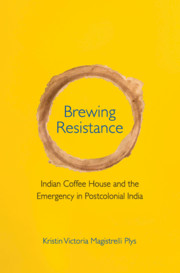Book contents
- Frontmatter
- Contents
- Acknowledgements
- 1 Introduction
- 2 How Anti-Colonial Labour Movements Create Anti-Authoritarian Autonomous Zones
- 3 Indira Gandhi’s Political Economy of Development
- 4 Social Movements of the 1970s
- 5 Emergency at Midnight
- 6 The Coffee House Movement
- 7 ‘Coffee House’ Workers’ Anti-Colonial Labour Movement
- 8 Conclusion
- Appendix I Photographs
- Appendix II Political Parties during the Emergency
- Appendix III Methodological Appendix
- Bibliography
- Index
7 - ‘Coffee House’ Workers’ Anti-Colonial Labour Movement
Published online by Cambridge University Press: 12 May 2020
- Frontmatter
- Contents
- Acknowledgements
- 1 Introduction
- 2 How Anti-Colonial Labour Movements Create Anti-Authoritarian Autonomous Zones
- 3 Indira Gandhi’s Political Economy of Development
- 4 Social Movements of the 1970s
- 5 Emergency at Midnight
- 6 The Coffee House Movement
- 7 ‘Coffee House’ Workers’ Anti-Colonial Labour Movement
- 8 Conclusion
- Appendix I Photographs
- Appendix II Political Parties during the Emergency
- Appendix III Methodological Appendix
- Bibliography
- Index
Summary
Inquilab (revolution) does not mean the transfer of state from the hands of the British to the Indians, but to those Indians who are at one with us as to the final goal … to proceed in earnest is to organise the reconstruction of the whole society on a socialist basis. If you do not mean this Inquilab, then please have mercy. Stop shouting ‘Inquilab Zindabad ‘ [Long Live Revolution].
—Bhagat Singh, To Young Political Workers (1931)In his memoirs, Nadakkal Parameswaran Pillai, Indian Coffee House worker at the Trichur location of the firm, writes that the Indian Coffee House found its place in history through its ‘martyrdom’ at the hands of Sanjay Gandhi during the Emergency (Pillai 2005: 89). Pillai writes that the Connaught Place location of Indian Coffee House was the biggest source of the Indian Coffee House workers’ ‘confidence’ in themselves and their abilities having started by selling coffee on the street and still beating local competition, to collectively owning a building in the heart of Delhi that was a central meeting place for ministers, bureaucrats, intellectuals, artists and cultural activists.
That the Indian Coffee House became an autonomous zone during the Emergency is on the surface a puzzle if one considers its historical origins as a colonial firm. However, its transformation into a workers’ cooperative attracted regular customers who were politically and artistically engaged, thereby paving the way for its transformation into an autonomous zone by the Emergency. That the Indian Coffee House workers adopted the cooperative as their legal organisational form was unexpected, more so because the Communist Party of India (CPI) (undivided) organised this workers’ movement. In the decades leading up to 1957, the year the Indian Coffee House officially became a workers’ cooperative, there was a consensus among Communist Party leadership on pursuing a strategy of nationalisation of industry as the road to national development and Socialism in India. There were debates among party leadership on how to achieve this goal of nationalisation, but not whether nationalised industry was the appropriate strategy. And yet the CPI organised the newly unemployed coffee board workers into a workers’ cooperative, not a state-owned enterprise.
- Type
- Chapter
- Information
- Brewing ResistanceIndian Coffee House and the Emergency in Postcolonial India, pp. 250 - 288Publisher: Cambridge University PressPrint publication year: 2020



